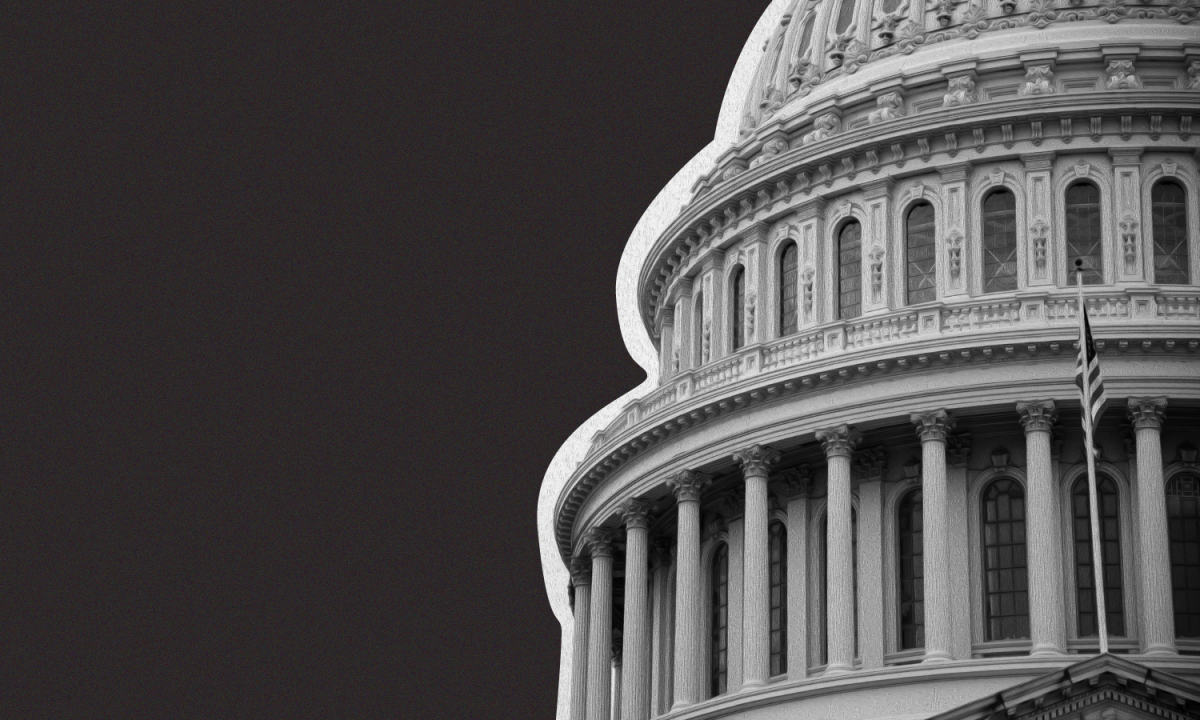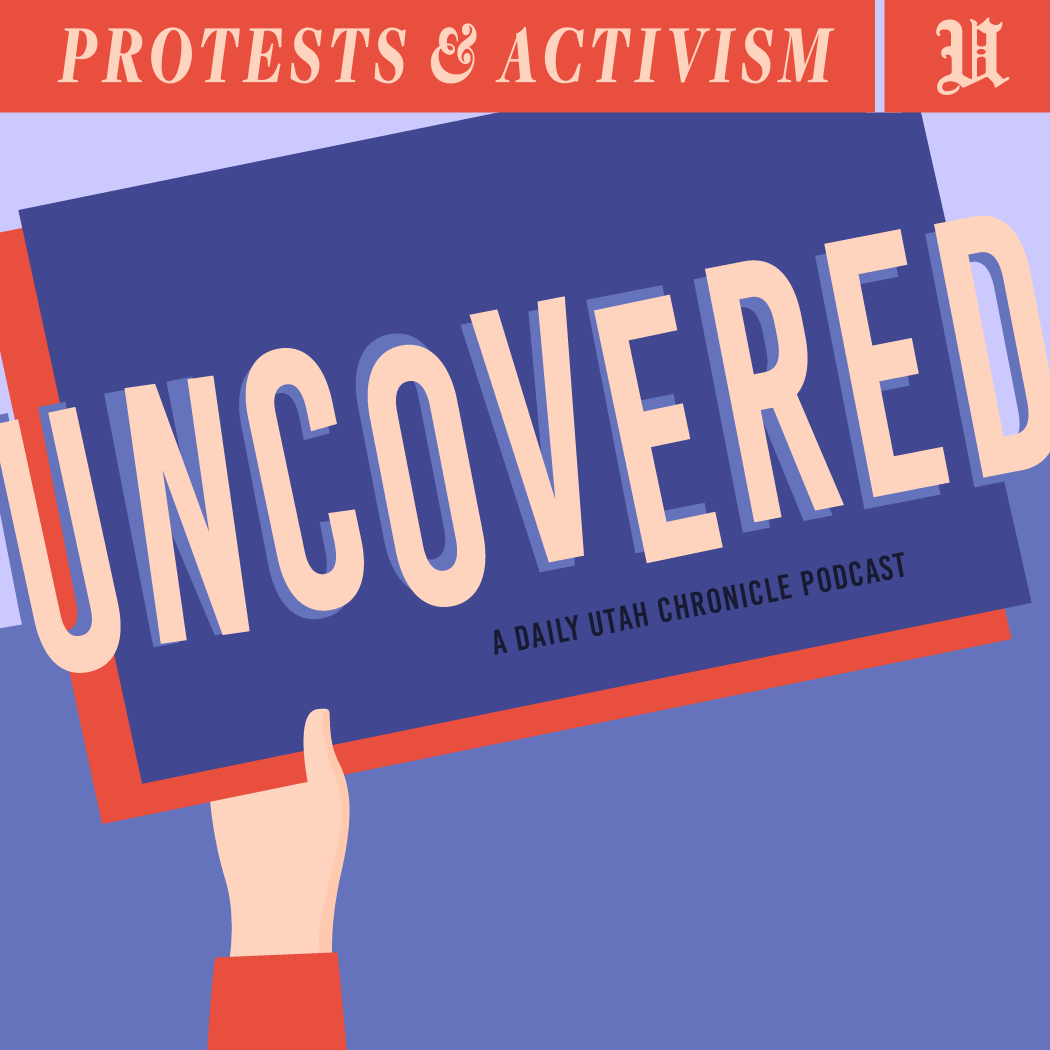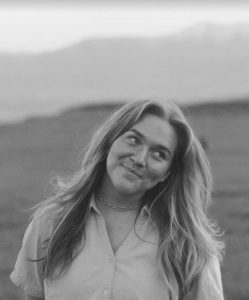Transcript
Emma Ratkovic: Hello and welcome back to Uncovered the Daily Utah Chronicle’s Investigative Podcast. I’m your host, Emma Ratkovic. And on today’s episode of the podcast, I’m joined by investigative writer Caroline Krum. Caroline recently wrote a story about the U’s history of student protests and activism for the January print edition of the Chrony. Hi, Caroline, thank you so much for joining me on the podcast again today.
Caroline Krum: Thanks for having me.
Emma Ratkovic: All right, let’s jump right into it. So in your story, you mentioned that student protests are not new at the U. You shared that the protests against U.S. involvement in the Vietnam War were among the most memorable on campus events. Could you elaborate on the specific events that took place and the order in which they happened?
Caroline Krum: Yeah, so in October of 1967, U students organized a debate about the Vietnam War to take place in the Union Ballroom, arguing whether the U.S. should stay in the Vietnam War and the anti Vietnam War side won by a longshot. Following the debate was anti war rallies, sit-ins, teach-ins, and then in 1969, a chapter of the Students for a Democratic Society was founded on campus. After the shootings at Kent State, Utah students organized a major protest against the shootings and the U.S. involvement in the Vietnam War. And that is what led to 1000s of U students protesting and occupying the park building. The war was close to many Utahns heart since Utah had the fifth highest percentage of young men who served in the Vietnam War.
Emma Ratkovic: Oh, that’s super interesting. I had no idea that Utah would have a fifth-highest percentage. So you also describe that in 1995, U students also protested the Chinese occupation of Tibet. Could you give more details about what had happened in Tibet and the reasons behind the U student protests?
Caroline Krum: Yeah, so I pulled this from the 105th volume of the Daily Utah Chronicle that came out in October of 1995. And in 1959, Communist China entered Tibet to add stability to the region, but then they ended up never leaving, and so students were accusing China of engaging in a genocide. One student specifically said that Tibet has a population of 6 million, but since China began their occupation, 1.2 million are unaccounted for either killed off or imprisoned. Students also discussed how China was committing a what they called cultural genocide by restructuring Tibet educational system, taking away their democratic government and banning the Buddhist religion. So to protest this around 50 Tibetans hosted demonstration in front of the Wallace F. Bennett Building, advocating to free Tibet.
Emma Ratkovic: I had no idea that was a thing. In 1986, there was yet another student demonstration against apartheid in South Africa. Caroline, you described that there was a club called the Students Against Apartheid at the U, does this club still exist? And what led to the formation of this club and when was it started?
Caroline Krum: So the club was formed specifically in response to the apartheid occurring in South Africa, and students approaching the U investing in companies that support this apartheid. So from what I found, it seems the club no longer exists. But all data about this club seems to exist starting and ending in the 1980s and they are not currently listed as an organization at the U.
Emma Ratkovic: Okay, the club set up shanties or wooden-like hut structures near the Union. Why had these shanties been built up and what had happened after the setup?
Caroline Krum: So the club set up the shanties and stated that they’d be building kind of like a shanty town, putting up multiple all over campus, and they use these to advocate for black rights in South Africa. And then sometimes even camp inside the shanties. Students said that they did this specifically to dramatize the plight of South African blacks and that they were going to keep these shanties up until the you divested from the companies that were funding apartheid.
Emma Ratkovic: Very interesting. So what actions were organizations and students at the U requesting from the U?
Caroline Krum: So the main thing they were calling for was what they called divestment, which was kind of pulling out investments. But it was the name given calling the U to pull out of there and to pull their investments into companies funding South African apartheid out the U claimed that these investments were only business related, and that they weren’t politically motivated, say that, like they had kind of nothing to do with the apartheid but students claimed that they did not support the university that they paid for to fund apartheid in South Africa.
Emma Ratkovic: And can you highlight the incidents that were committed by movement opponents?
Caroline Krum: Yeah, so there were counter-protests and flyers and information, but the main conflict occurred when opponents threw a fire bomb at the shanty and it was filled with student protesters. So it happened during night, but no one was harmed. But it does show the extreme viewpoints that some people are willing to harm other students in order to get their points across.
Emma Ratkovic: Yeah, wow. That’s definitely a big deal. So after the demonstration, did the U make any changes?
Caroline Krum: Yeah, the U passed a resolution in support of South Africa. And they stated that they would now only be investing in companies that they felt like were making progress.
Emma Ratkovic: So the topic of racial minority rights has been prevalent at the U. As you know, you wrote that students who identify as Chicano are more likely to experience difficulties in higher education. What exactly does it mean to be Chicano? And where’s this term derived from?
Caroline Krum: So I can’t personally speak take on what it means to be Chicano, because it really is a complex multifaceted identity. But the term tends to be associated with a Mexican identity. It kind of was created to differentiate from just Hispanic because it doesn’t just mean having Spanish roots. It means specifically having Mexican or indigenous heritage, and it really originated in the 1960s and kind of became a unifying term for people who found themselves belonging to Mexican American identity, community and or ancestry.
Emma Ratkovic: So can you elaborate on the statistics on the Chicano population at the U?
Caroline Krum: So currently, the U doesn’t really have Chicano statistics available, they only really show Hispanic. But that being said, Hispanic students make up around 12% of the undergrad population, while Hispanics make up around 18% of Utah’s population. So you can see they’re kind of underrepresented there. And in the 70s, when the Chicano Student Association was starting, they came out with a bunch of statistics that show that the Chicano community had the highest employment rates, the highest dropout rates, the highest criminal rates and the worst housing per capita in 1970, the U had 120 Chicago students out of their 22,000 students, so less than half of 1% of students were Chicano.
Emma Ratkovic: Wow. Is the U’s Chicano Student Association still in existence in 2024? If so, what is their current mission and how has the Chicano population changed over time at the U?
Caroline Krum: So there’s things that the Chicano Student Association worked to when they were around that are still here. One of those is the Chicano Scholarship Fund, which still exists nowadays. But the actual club itself doesn’t exist. But the U does have the Latinx Student Union, which is new since then, and also Mecha, both of which were created to advocate for black and brown students, as well as provide a community and resources for Mexican-American students.
Emma Ratkovic: And then going along with that protests at the U erupted in response to racism and prejudice towards black students. You mentioned some of the most notable figures of the protests. What part did Charles Nabors and Ronald Coleman play in the protests that had taken place?
Caroline Krum: Nabors and Coleman helped to organize the protests against race-based discrimination, both of these faculty members discussed their personal experience with racism at the U, since they were both black men. And they were faculty that could kind of help guide students on how to go about having protests and organize them and put them together for students.
Emma Ratkovic: And how did Black students and faculty support the cause? And what actions did they take?
Caroline Krum: So black students created the Black Student Union, which actually is still around today, and is an official club at the U. They held protests, they started boycotts, they participated in sit-ins, they hosted anti-war rallies, but they also protested against housing discrimination and the severe racism that they were experiencing.
Emma Ratkovic:
And then you did mention in your story that black faculty members and students confronted racism in the LDS church. How exactly did they go about that?
Caroline Krum: So there’s a couple of different things members of the Black community that you confronted racism one by calling out the racism in Mormon doctrine. The Doctrine they’re referring to is like scriptures that say that the dark skin of African descendants is a curse put on the Lamanites as punishment for being evil. They also protested the LDS Church’s silence during the Civil Rights Movement, as well as their lack of support for the black community. An example of this is the priesthood which is something that exists in the Mormon religion, sort of like a special power given to men in the Mormon church, but it was not given to black men until 1978, which was obviously well after the Civil Rights Movement. So they held protests, they called for changes in the church. And they even protested when a singer was going to perform at the conference center due to the church’s ties with racism.
Emma Ratkovic: Very interesting. So what exactly is Mecha? And what protests did they hold in 2023?
Caroline Krum: Mecha has had a couple of different protests. In April, they held a protest against YAF’s transphobia during Pride Week, they put up a couple of posters that offended a lot of people in the transgender community. They protested a YAF event again this November, when the club attempted to hold a screening for the film Damaged, which is a film about the detransitioner Chloe Cole. They had a couple of protests calling for the free Palestine movement. And then they had a protest or a sit-in to reinstate their sponsorship and to also call on the university to meet their list of demands.
Emma Ratkovic: And what was the response and course of action followed by U students and faculty when Mecha lost their group sponsorship,
Caroline Krum: So Mecha lost the sponsorship in response to violating the university’s free speech policy, and the university claimed that protesting the YAF event and not allowing the other event to take place Mecha had infringed on YAF’s free speech rights, or the rights of another club, so then they would have their sponsorship taken away. As a result, the university also stated that Mecha was being reprimanded for not being cooperative with the university and violating clubs sponsorship policies.
Emma Ratkovic: And your story you mentioned that the area behind the union was supposedly changed to prevent people from congregating there. Can you describe how that changed?
Caroline Krum: Yeah, so the Union back patio used to be a really flat grassy area and if you view University photos from like the 60s, you can still see students sitting in this sort of open field but now the Union back patio is filled with trees, small hills and multiple concrete paths. So with this happening during a time when the space was being used for demonstrations. There’s a kind of widely held belief that this was done to discourage students from using this space for protests and Rachel and MJ write an investigative piece on this that everyone should read on the website.
Emma Ratkovic: Oh, yeah, definitely. So in the wake of student demonstrations against South African apartheid, what actions did the U’s Institutional Council take?
Caroline Krum: Well, according to the Daily Utah Chronicle in an issue published Feb. 11 1986, the University of Utah’s Institutional Council passed a resolution that quote, “was reaffirming its support of human rights in South Africa and its opposition to apartheid” end quote, the U also tied investments to companies under the Sullivan Principles, and the Sullivan Principles were kind of a code of conduct that were used as a guideline for companies doing business in South Africa. The resolution stated that the council will continue to monitor investment in companies doing business in South Africa. But many students felt like this was not nearly enough and that the U needed to be doing a lot more.
Emma Ratkovic: And then Caroline, in your own words, how can employees and students at the U safely demonstrate for their rights?
Caroline Krum: I think peaceful, nonviolent protest is always the safest way to avoid individual harm or repercussions. It’s also always a good idea to notify U staff in advance that you will be holding a protest because that prevents the U from being able to completely shut it down. That’s one of the issues that Mecha ran into this year of having to notify faculty of their protests. But it’s also super important that you know your rights, you should know what you can or can’t say, know what you can or can’t do know when you are or are not being detained know what you have to tell police and what you don’t have to tell them, etc. So I think being well informed is the most important.
Emma Ratkovic: Do you have any final thoughts or comments?
Caroline Krum: Yeah, I think protesting is super important. And I think it’s a natural part of democracy. I think it’s also natural that major institutions like the U would supposedly oppose student protests. But as long as they don’t harm people or property, they are always protected. You have every right to protest. And if you see injustice happening, I strongly encourage you to learn your rights and take to demonstrating.
Emma Ratkovic: All right, thank you so much for joining me on the podcast today, Caroline.
Caroline Krum: Thank you for having me.
Emma Ratkovic: And I’m your host, Emma Ratkovic. And thank you so much for tuning into this episode of Uncovered make sure to listen to our future episodes.
Producer and Host: Emma Ratkovic [email protected] // @eratkovic_news
Guest: Caroline Krum [email protected] // @CarolineChrony





















John Hedberg • Jan 26, 2024 at 2:20 pm
Glenn Loury and John McWhorter (professors at Brown and Columbia, I think) had an interesting conversation recently on YouTube’s “The Glenn Show” titled “The Truth About George Floyd’s Death”. It turns out that the activists were spreading misinformation: George Floyd wasn’t murdered. Oops!
It’s the penchant of activists not to wait for emerging data to tell the whole story before coming to faulty conclusions based on incorrect assumptions (hypotheses). In this case, the BLM riots caused the death of more than a dozen innocent human beings, many of them BIPOC, because of a murder that wasn’t a murder, as horrific as it was.
Democracy isn’t based on activism but persuasion and reason, science which is based on evidence that emerges and conclusions which change over time, so was it worth the death of more than a dozen innocent people, many of whom were BIPOC, to protest a horrific death which it turns out wasn’t murder now that the facts are better known?
If you’re a true student of human rights and care about people of all stripes, watch “The Truth about George Floyd’s Death | Glenn Loury & John McWhorter | The Glenn Show” posted a few weeks ago. There’s also a documentary that’s got data that never made it into the trials of the police officers.
No justice without honesty, nor without ‘Love thy Neighbor as Thy Self’, since only this equal Love of every child in God’s eyes (By Whatever Name) makes all life’s inevitable suffering meaningful and heals it. We all fall down: only Love forgives our scrapes and collisions and gets us back leaping, learning, and growing again in the pursuit of a more perfect union as maturing members of our human family, the only true ‘safe space’ mortal life allows (as safe as any Parent can make it, considering how clumsy we can be as children~😋).